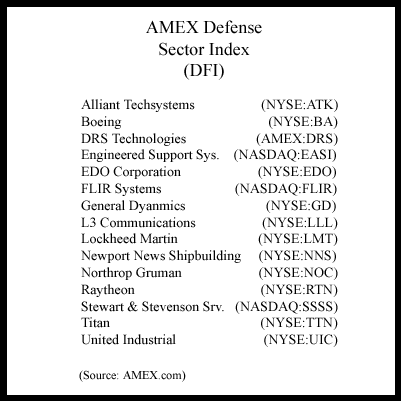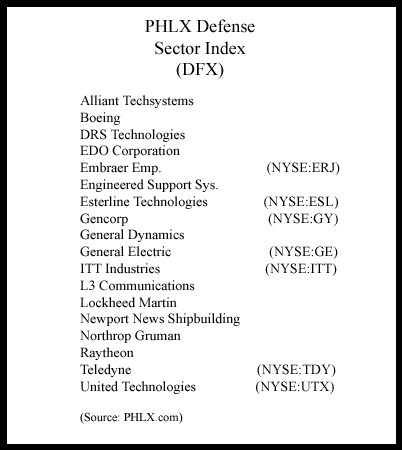
HOT TOPICS LIST
- MACD
- Fibonacci
- RSI
- Gann
- ADXR
- Stochastics
- Volume
- Triangles
- Futures
- Cycles
- Volatility
- ZIGZAG
- MESA
- Retracement
- Aroon
INDICATORS LIST
LIST OF TOPICS
PRINT THIS ARTICLE
by Eric Utley
Two new sector indices for the defense sector, DFI and DFX, may provide some insight into the defense sector as a whole.
Position: N/A
Eric Utley
Eric Utley is a professional trader and contributing editor to www.OptionInvestor.com, a web-based newsletter that serves stock and options traders. While he cannot give investment advice, Eric welcomes your questions at eutley@optioninvestor.com.
PRINT THIS ARTICLE
INDEX OPTION TRADING
Playing Defense
11/08/01 01:33:39 PMby Eric Utley
Two new sector indices for the defense sector, DFI and DFX, may provide some insight into the defense sector as a whole.
Position: N/A
| The defense sector garnered investor attention following the September 11 attacks on America. Oddly enough, government spending on defense was on the rise prior to the recent attacks. Defense spending ballooned in the early 1980s under President Reagan, but slipped into a recession in the latter part of the decade as the fall of the Berlin Wall and the break up of the former Soviet Union necessitated less spending on defense. Or so it was perceived. Spending rebounded in the early 1990s as the industry went through a major consolidation; many smaller contractors merged into their larger brothers, leaving several heavyweights, such as Northrop Gruman (NYSE:NOC), Lockheed Martin (NYSE:LMT), Boeing (NYSE:BA), Raytheon (NYSE:RTN), and General Dynamics (NYSE:GD) to fulfill the government's defense needs. |
| Proposed defense budgets measurably grew in recent years, notably under the Clinton administration. From 1999 to 2001, proposed spending increased from $257 to $291 billion, respectively. However, President Bush's budget request for 2002 is the largest sequential increase in proposed spending in recent years. The President is requesting roughly $329 billion for 2002 -- a 13 percent increase over President Clinton's last request. Moreover, emergency spending in the wake of the attacks will increase current spending all the more. Some industry analysts expect spending to top $400 billion very soon. The increase in spending has piqued the interest of Wall Street. And the financial media's recent emphasis on the defense sector has done the same for Main Street. In light of the renewed interest in the industry, The American Stock Exchange and Philadelphia Stock Exchange recently rolled out their own defense sector indices. The AMEX Defense Sector Index trades under the symbol: DFI. It began trading on October 23. Options on the index recently began trading, too. Options on the DFI.X are European style; they can only be exercised on the last business day prior to expiration. The DFI is an equal-dollar weighted index and is comprised of the following components: |

|
| Figure 1: Components of the DFI index. |
| |
| The Philadelphia Stock Exchange's defense sector trades under the symbol: DFX. It, too, is a dollar-weighted index, but includes a total of 18 companies -- three more than the DFI. Options on the DFX are American style, denoted by the 'X' in the sector symbol. American style contracts allow the holder to exercise at any time prior to expiration. However, options are not yet available on the DFX. The underlying index DFX began trading on November 2, 2001. There is overlap in the components of the DFI and DFX, but enough differences to distinguish the two. The components of the DFX are as follows:  Figure 2: Components of the DFX index |
| Like most sector indexes, options on the DFI and DFX are likely to trade thinly. Indeed, at the time of this writing (11/7/2001), there were only five contracts of open interest across all of the DFI strikes. And forget about the bid/ask spreads. Wide is an understatement. The DFI and DFX options are unlikely to attract speculators. They're more likely to attract portfolio managers in need of a hedge in the defense sector. Individuals, however, may find value in the DFI and DFX indices, particularly those with a top-down approach of viewing the market. Those who view the market by the major averages and narrow-based sector indexes now have another industry group to monitor in the defense sector with the creation of the DFI and DFX. Whether or not the creation of the DFI and DFX mark the beginning of a long-term bullish trend in the defense sector remains to be seen. Some might label the creation of the indices a contrarian indicator. The defense industry is obviously levered to government spending habits, which adds an element of risk to any investment in the group. The recent boost in government spending in the wake of the September 11 attacks has already been factored into the sector. That much could be observed in the price action of shares of Lockheed Martin following the announcement of the Joint Strike Fighter contract win. Nevertheless, the creation of the DFI and DFX allows traders to better observe the defense sector as a whole. And through the components listed above, find potential trades from those observations. |
| At the time of publication Eric held no positions in any securities mentioned, although holdings can change at any time. |
Eric Utley is a professional trader and contributing editor to www.OptionInvestor.com, a web-based newsletter that serves stock and options traders. While he cannot give investment advice, Eric welcomes your questions at eutley@optioninvestor.com.
| Title: | Contributing Editor |
| Company: | OptionInvestor.com |
| Website: | www.OptionInvestor.com |
| E-mail address: | eutley@optioninvestor.com |
Traders' Resource Links | |
| OptionInvestor.com has not added any product or service information to TRADERS' RESOURCE. | |
Click here for more information about our publications!
Comments

|

Request Information From Our Sponsors
- StockCharts.com, Inc.
- Candle Patterns
- Candlestick Charting Explained
- Intermarket Technical Analysis
- John Murphy on Chart Analysis
- John Murphy's Chart Pattern Recognition
- John Murphy's Market Message
- MurphyExplainsMarketAnalysis-Intermarket Analysis
- MurphyExplainsMarketAnalysis-Visual Analysis
- StockCharts.com
- Technical Analysis of the Financial Markets
- The Visual Investor
- VectorVest, Inc.
- Executive Premier Workshop
- One-Day Options Course
- OptionsPro
- Retirement Income Workshop
- Sure-Fire Trading Systems (VectorVest, Inc.)
- Trading as a Business Workshop
- VectorVest 7 EOD
- VectorVest 7 RealTime/IntraDay
- VectorVest AutoTester
- VectorVest Educational Services
- VectorVest OnLine
- VectorVest Options Analyzer
- VectorVest ProGraphics v6.0
- VectorVest ProTrader 7
- VectorVest RealTime Derby Tool
- VectorVest Simulator
- VectorVest Variator
- VectorVest Watchdog
